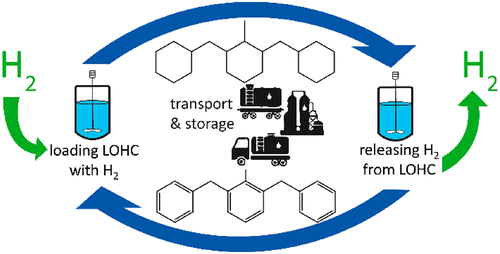当前位置:
X-MOL 学术
›
ACS Sustain. Chem. Eng.
›
论文详情
Our official English website, www.x-mol.net, welcomes your
feedback! (Note: you will need to create a separate account there.)
Hydrogen Production Based on Liquid Organic Hydrogen Carriers through Sulfur Doped Platinum Catalysts Supported on TiO2
ACS Sustainable Chemistry & Engineering ( IF 7.1 ) Pub Date : 2021-03-16 , DOI: 10.1021/acssuschemeng.0c09048 Ximeng Chen 1 , Christian H. Gierlich 1 , Simon Schötz 2 , Dominik Blaumeiser 2 , Tanja Bauer 2 , Jörg Libuda 2 , Regina Palkovits 1
ACS Sustainable Chemistry & Engineering ( IF 7.1 ) Pub Date : 2021-03-16 , DOI: 10.1021/acssuschemeng.0c09048 Ximeng Chen 1 , Christian H. Gierlich 1 , Simon Schötz 2 , Dominik Blaumeiser 2 , Tanja Bauer 2 , Jörg Libuda 2 , Regina Palkovits 1
Affiliation

|
In order to move from a carbon-based energy system to a more sustainable one, focus is put on liquid organic hydrogen carrier (LOHC) systems for CO2-free hydrogen storage and release. In this study sulfur as a dopant for the Pt/TiO2 catalyst was identified to be a selective poison resulting in high performing catalysts in the dehydrogenation experiments with the LOHC system perhydro dibenzyltoluene/dibenzyltoluene (H18-DBT/H0-DBT). The Pt/TiO2 and S–Pt/TiO2 catalysts were compared to the current benchmarks Pt/γ-Al2O3 and S–Pt/γ-Al2O3. S–Pt/TiO2 was found to achieve a high degree of dehydrogenation of 98% which is competitive to the benchmark S–Pt/γ-Al2O3. In addition, analyses of the side products resulted in a higher selectivity toward dibenzyltoluene for S–Pt/TiO2 than for the γ-Al2O3 supported catalysts. Characterization with infrared spectroscopy (IR), transmission electron microscopy (TEM), and diffuse reflectance infrared Fourier transform spectroscopy with CO as adsorbing molecule (CO–DRIFTS) suggest the presence of strongly chemisorbed sulfur species as well as SMSI effects of the Pt/TiO2 catalysts. Based on kinetic studies, a batch and plug flow reactor for the dehydrogenation reaction were simulated for both titania supported catalysts. According to the calculations, the sulfur doped catalyst displays higher conversions in both batch and plug flow operation as compared to the unmodified system Pt/TiO2.
中文翻译:

TiO 2负载的硫掺杂铂催化剂在液态有机氢载体上制氢
为了从基于碳的能源系统转变为更可持续的能源系统,重点是用于无CO 2氢存储和释放的液态有机氢载体(LOHC)系统。在这项研究中,硫作为Pt / TiO 2催化剂的掺杂剂被确定为选择性毒物,在LOHC系统全氢二苄基甲苯/二苄基甲苯(H18-DBT / H0-DBT)的脱氢实验中,该催化剂导致了高性能的催化剂。将Pt /的TiO 2和S-的Pt /二氧化钛2催化剂相比,目前的基准的Pt /γ-Al系2 ö 3和S-的Pt /γ-Al系2 ö 3。S–Pt / TiO 2发现实现了高程度的98%脱氢中的哪一个基准S-的Pt /γ-Al系的竞争2 ö 3。此外,分析产品导致朝向二苄基甲苯更高的选择性为S-的Pt /氧化钛侧的2比对于在γ-Al 2种ö 3种的负载型催化剂。用红外光谱(IR),透射电子显微镜(TEM)和漫反射红外傅里叶变换光谱(以CO为吸附分子)(CO-DRIFTS)进行表征,表明存在强化学吸附的硫物质以及Pt / TiO的SMSI效应2个催化剂。基于动力学研究,针对两种二氧化钛负载的催化剂模拟了用于脱氢反应的间歇式和活塞流反应器。根据计算,与未改性体系Pt / TiO 2相比,硫掺杂的催化剂在间歇和活塞流操作中均显示出更高的转化率。
更新日期:2021-05-17
中文翻译:

TiO 2负载的硫掺杂铂催化剂在液态有机氢载体上制氢
为了从基于碳的能源系统转变为更可持续的能源系统,重点是用于无CO 2氢存储和释放的液态有机氢载体(LOHC)系统。在这项研究中,硫作为Pt / TiO 2催化剂的掺杂剂被确定为选择性毒物,在LOHC系统全氢二苄基甲苯/二苄基甲苯(H18-DBT / H0-DBT)的脱氢实验中,该催化剂导致了高性能的催化剂。将Pt /的TiO 2和S-的Pt /二氧化钛2催化剂相比,目前的基准的Pt /γ-Al系2 ö 3和S-的Pt /γ-Al系2 ö 3。S–Pt / TiO 2发现实现了高程度的98%脱氢中的哪一个基准S-的Pt /γ-Al系的竞争2 ö 3。此外,分析产品导致朝向二苄基甲苯更高的选择性为S-的Pt /氧化钛侧的2比对于在γ-Al 2种ö 3种的负载型催化剂。用红外光谱(IR),透射电子显微镜(TEM)和漫反射红外傅里叶变换光谱(以CO为吸附分子)(CO-DRIFTS)进行表征,表明存在强化学吸附的硫物质以及Pt / TiO的SMSI效应2个催化剂。基于动力学研究,针对两种二氧化钛负载的催化剂模拟了用于脱氢反应的间歇式和活塞流反应器。根据计算,与未改性体系Pt / TiO 2相比,硫掺杂的催化剂在间歇和活塞流操作中均显示出更高的转化率。


















































 京公网安备 11010802027423号
京公网安备 11010802027423号